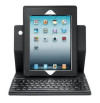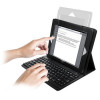As well as being Editor-in-Chief and Community Administrator here at DaniWeb, for the last 20 years I have also been a freelance journalist (writing for national newspapers as well as being Contributing Editor of PC Pro, the best selling computer magazine in the UK) and am fortunate enough to have seen more than 20 of my books published for good measure. To put that into some perspective, working on an average of 6,000 words per week for 20 years I have an output of more than 6 million published words to my name.
Keyboards are, therefore, pretty important to me. I break cheaply constructed ones, I simply cannot use badly designed ones and admit to being rather picky about what I consider a suitable keyboard to sit in front of for hours at a time.
So when DaniWeb had the opportunity to road test the Kensington KeyFolio Pro Performance Keyboard Case I was both a little sceptical and a little excited about biting the bullet and using my iPad 2 in order to produce all my professional output for three days. I had good reason for my reticence after all; firstly there's the iPad 2 itself which is not exactly blessed with what I would call 'writer-grade' word processing apps (Pages being the best of the bunch, and the one I used throughout the keyboard testing) and secondly there is the keyboard thing itself. Being a writer I have, naturally, already explored the iPad keyboard market as the on-screen variety is great for quick email or banging out a login but precious little else. Truth be told I had, in fact, invested in the original Kensington KeyFolio keyboard case with mixed results. I quite liked the faux-leather (and therefore ethically acceptable for an animal rights activist such as myself) padded case, and the rubber-keyed keyboard itself had the advantage of being beer, coke and waterproof. But that's just about where the positives ended: rubber bubble keys are never truly responsive, there is no typing feedback, and the small size of the keyboard and keys made for far too uncomfortable an experience with far too many typos. I ended up using it for composing emails, participating in DaniWeb forums and even compiling research documents but not ever writing a piece for publication. Could the 'Pro' version compensate for these negatives and allow me to be productive during a particularly busy week of writing commissions?
There was only one way to find out: use it... The ability to quickly swivel the iPad in the case into portrait mode and be able to type with a full page in view within your word processing application is a welcome addition over the original KeyFolio case which was landscape or nothing. Whichever orientation you opt for, the case itself keeps the iPad feeling solid and stable during typing. The reinforced polyurethane construction may not be to everyone's taste and it does, I admit, have something of a cheap fake leather feel about it. However, it provides excellent protection for the iPad itself both from the interior and exterior perspective. It offers a nice snug fit, with no danger of your iPad falling from the thing no matter how irresponsibly you hold it. The flipside being the additional weight and bulk it brings to the tablet computing experience. In terms of weight, think of the case weighing about the same as the iPad 2 and in terms of bulk, well, with the iPad 2 in situ it all but quadruples the thickness of the naked tablet. Now for me this wasn't a great problem as I tend to think if you need a keyboard then that is the obvious sacrifice that needs to be made. Some of my colleagues who held the thing decided it was not for them, just as a protective iPhone case was not for them: if you want your iPad to be slim and sexy and on display to all, then it's probably not for you either. However, here's the thing, if you are not going to be doing the 'needs a keyboard for typing work' thing then just slip the iPad out of the case and don't take the case with you that trip out and you have yourself a tablet back instead of a slim touch-screen netbook-a-like device. Sorted. Battery life was excellent. I charged the keyboard fully before using for the first time, which took four hours, and then never needed to charge it again. To put that into some kind of perspective, I used the keyboard for a total of 18 hours and 30 minutes during my three days of putting it through the real world paces and it didn't need recharging at all. Kensington claims that the 430 mAh Lithium-Ion battery will last for 100 hours of solid working, or 60 days in standby mode. The original KeyFolio claimed 90 hours of charge and I managed to get 86 hours out of it so I would imagine that somewhere between 90 and 100 hours for the KeyFolio Pro would be about right. Which is not only impressive, but rather welcome given that the whole point of an iPad and therefore an iPad keyboard is to enable mobile working, working away from the home or office environment. I felt confident that if I charged the keyboard up once per week I would never actually run out of charge when I needed it out in the field as it were. Oh, and it charges via a micro-USB connector for added convenience. There are some additional 'command' keys added for iPad 2 use, so you can bring up a photo slideshow with a single press or get to the search screen from a single keyboard press for example, as well as get to the home screen, turn the screen off and control multimedia displays. Simple things that you don't necessarily expect from this kind of keyboard come as standard, by which I mean the likes of a caps lock light and a decent sized shift key. Sure, you sacrifice a numerical keypad, but then again you do on a netbook keyboard for that matter. The keyboard itself is larger than the older rubber version, and this additional size really does express itself in usage: even though we are still talking netbook rather than laptop keyboard here in terms of key size and spacing, it feels so responsive that I could easily manage my usual 75/80 words per minute without making any more errors than usual. Now that is, in my never humble opinion, pretty impressive for a travel keyboard such as this. I didn't suffer from any key slippage at all, finding the laptop style scissor keys themselves to be both of a good size and 'grippy' for want of a better word. I like the key travel which feels right, by which I mean that just like with a laptop keyboard you know when you have hit a key because you can feel it, you get the tactile feedback that you need and which a rubberised button keyboard simply doesn't provide. The keyboard is of the BlueTooth variety, but worry not as it was both easy to connect (switch on, go to iPad settings, enter code displayed using the keyboard, and that's it) and reliable once connected. Throughout the testing period the connection was never lost once, it was rock solid and for all intents and purposes I could have been using a wired keyboard. Don't be fooled into thinking this is an expensive option either as it's actually great value for money if you are looking for both a case and an external keyboard for your iPad, plus there's the added advantage of having them all in one reasonably sized item rather than having to carry the keyboard around separately.
So, purely from the perspective of a professional, jobbing, writer how good is the Kensington KeyFolio Pro? Well let's put it this way, not only was this entire review written using it, but I've decided to replace my older KeyFolio case with one of these and use it on a daily basis. At last I can ditch the netbook and just take the iPad with me on my travels. The Kensington KeyFolio Pro has transformed the iPad into an industrial strength writing tool at last. Now, if only I could get Apple to tweak the Pages app just a little bit and add those features that full time writer craves, I would be in hog heaven...
You can see the Kensington KeyFolio Pro Performance Keyboard Case in action here:
[youtube]aFrYCAMtLzs[/youtube]





